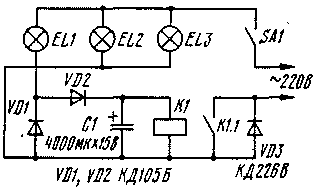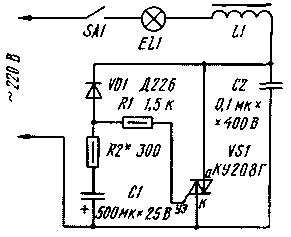
|
|
ENCYCLOPEDIA OF RADIO ELECTRONICS AND ELECTRICAL ENGINEERING Automatic lamp protection against burnout. Encyclopedia of radio electronics and electrical engineering
Encyclopedia of radio electronics and electrical engineering / Lighting The problem of the durability of incandescent lamps, which sometimes burn out at the moment they are connected to the network, remains relevant. Some options for its solution are described in the proposed materials. ...on relay and trinistor It is known that the resistance of an incandescent filament of a lighting lamp in a cold state is much less than the resistance of an incandescent filament. For this reason, as soon as the lamp is turned on, the current through the filament is much higher than the rated current and it sometimes burns out. This happens most often at times when the lamp on coincides with the maximum half-wave of the mains voltage. One of the options to extend the "life" of the lamp is to connect a semiconductor diode in series with it. Then the probability of the coincidence of the moment of switching on with the maximum of the half-wave decreases by half [1] - after all, the current will now flow through the lamp in only one direction, say, with positive or negative half-cycles. Since the luminous efficiency of the lamp decreases with such power supply, automatic machines are often used, which, after preheating the filament, supply the lamp with full mains voltage. The "starting" current in this case is less dangerous compared to the option of applying voltage to a cold thread. This is how the two-stage inclusion of an incandescent lamp is carried out, which can significantly extend its service life. In 1990, the author proposed a device [2] that works according to this principle. True, it was assembled on the KT848A transistor, which was in short supply at that time, used in automotive ignition systems. Such a device can be made on more accessible parts, in particular on a relay (Fig. 1) instead of a transistor. It is also a two-terminal network, and therefore it is easily integrated into existing electrical wiring. But unlike the prototype, it provides not a smooth limitation of the current flowing through the lamp at the moment it is connected to the network, but a stepped one: at first, only one half of the alternating current half-waves flows through the filament, and after a while - both.
Relay K1 is triggered by the current flowing through the mains switch SA1, lighting lamp EL1, relay winding, diode VD3 (or closing group of contacts K1.1). The device works like this. After closing the SA1 contacts, only positive half-waves of current pass through the lamp. In this case, the diode VD1 is closed, since the contacts K1.1 are still open. Capacitor C1 is gradually charged through the lamp and diode VD2, and as soon as the voltage across it reaches a certain value, relay K1 will operate, contacts K1.1 of which will bypass diode VD3. As a result, the EL1 lamp, which was burning at first "full light", will flash with a bright light. The delay in entering this mode depends mainly on the capacitance of the capacitor and the resistance of the relay winding. Since the relay coil is in series with the lamp, its resistance must be matched to the lamp's wattage. If one of the common 85 ohm winding automotive relays is used, the lamp can be from 40 to 100 watts. Then, with a 40 W lamp, a voltage of approximately 7 V will drop on the relay winding, 60 W - 10 V, 100 W - 16 V. With any of these voltages, small-sized automotive relays 111.3747, 112.3747, 113.3747, 113.3747-10, 114.3747-10, 114.3747-11, 116.3747-10, 116.3747-11, 117.3747-10, 117.3747 will be confidently rated at rated voltage 11-12, 85 work. The relay outputs are marked as follows: 86 and 30 - winding, 87 and XNUMX - normally open group of contacts. Of the general-purpose relays, it is possible to recommend for lamps with a power of 40-100 W RES10 passport RS4.524.304, RS4.524.302, RS4.524.308 (the last two - only for lamps 40 and 60 W) and RES9 passport RS4.524.202, RS4.524.203. With a capacitor C1 with a capacity of 4000 microfarads, the delay time of the relay operation reaches 1 s, which provides the necessary preheating of the lamp filament. Moreover, switching the lamp to full power occurs almost imperceptibly to the eye. In general, practice shows that 100 ms [2] is quite enough for reliable protection of lamps, therefore the time of 2...4 s [3] and even 5...10 s [4] sometimes recommended in the literature is clearly excessive. After all, the heating of an incandescent lamp occurs with a very small time constant, If the mains switch must switch not one, but several lamps (for example, chandelier lamps), their circuits should be separated, as shown in fig. 2. The EL1 lamp remains on as before through the relay winding, and EL2 and EL3 - through the VD3 diode and relay contacts K1.1. The power of additional lamps is limited only by the maximum current of the VD3 diode and the permissible current through the contacts. In this embodiment, the greatest preference should be given to an automotive relay, the contacts of which can withstand currents up to 30 A (though only at a voltage of 12 V).
A non-contact method of switching circuits of lighting lamps is also possible if a trinistor is used (Fig. 3). After closing the contacts of the power switch SA1, at first only negative half-waves pass through the lamp and the VD2 diode and the lamp burns "half-heartedly". After about a second, the capacitor C1 is charged through the diode VD1 and the resistor R1 to the opening voltage of the trinistor and the positive half-waves of the mains voltage begin to pass through the lamp - the lamp flashes to full brightness.
The power of the lamp (or a group of lamps connected in parallel) is limited by the limiting currents of the VD2 diode and the trinistor. If the trinistor operates without a heat sink, the power of the lamp (or lamps) should not exceed 200 watts. Diodes in the considered devices can be KD105B-KD105G, KD209A-KD209V, D226B, KD226V-KD226D. Instead of the trinistor KU202N, KU202L or KU201L is suitable. Literature 1. Vugman S.M., Kiseleva N.P., Litvinov V.C., Tokareva A.N. On the operation of an incandescent lamp in a half-wave rectification circuit. - Light engineering, 1988, No. 4, p. 8-10. 2. Bannikov V. Protection of electric lighting devices. - Radio, 1990, No. 12, p. 53. 3. Bzhevsky L. Dimmer with time delay.- Radio, 1989, No. 10, p.76. 4. Nechaev I. We adjust the brightness of the lamp. - Radio, 1992, No. 1, p. 22, 23. Author: V. Bannikov, Moscow ... on a triac Using the property of the triac to pass both half-cycles of the mains voltage, it is possible to assemble a relatively simple automaton according to the above scheme, capable of limiting the initial current surge through the cold filament of a lighting lamp. The machine is designed to work with lighting fixtures with a total power of up to 1500 watts. The power limiter, which provides two-stage switching on of the lamp, works like this. When the contacts of the SA1 mains switch are closed, the current in negative half-cycles of the voltage flows through the lamp EL1, the inductor L1, the diode VD1, the limiting resistor R1 and the control electrode circuit of the triac. The triac opens for these half-cycles, and the lamp burns "full light". At the same time, during these half-cycles, capacitor C2 is charged through the resistor R1. After 1 ... 2 s, when the lamp filament is already warmed up, capacitor C1 will charge to such a voltage at which the triac will open and in the positive half-cycles of the mains voltage - the brightness of the lamp will increase to normal.
To reduce the level of radio interference in the network that occurs during the operation of the triac, a filter is installed from the inductor L1 and capacitor C2. If the interference is not limiting, it is not necessary to install the specified filter parts. The KU208G triac in the device will completely replace the KU208V. Resistors - MLT-0,5, capacitor C1 - K50-16, C2 - K73-16, K73-17 or another for a rated voltage of at least 400 V. In place of the VD1 diode, in addition to that indicated on the diagram, you can install D226A, KD109B, KD221V or another with a reverse voltage of at least 300 V. The inductor is wound on a segment of a rod with a diameter of 8 or 10 mm and a length of 60 ... 70 turns of wire PEV-600 400. Establishing the device is reduced to the selection of the resistor R2, depending on the opening threshold of the applied triac. To do this, a load is connected to the device with which the machine will work, and instead of the resistor R2, a variable resistor with a resistance of more than 300 Ohms is temporarily soldered. By moving the resistor slider and applying voltage to the SA1 switch, such a resistor resistance is selected at which the EL1 lamp lights up with full heat 1 ... 2 s after switching on. Then, in place of R2, a constant resistor of such (or possibly close) resistance is soldered. Since the machine is made in the form of a two-terminal network, its parts can be placed in the body of a lamp or chandelier without laying additional wires. If the total power of the chandelier lamps exceeds 300 W, the triac is installed on a radiator with a cooling surface of at least 100 cm2. Author: A. Novikov, Perm; Publication: N. Bolshakov, rf.atnn.ru
Machine for thinning flowers in gardens
02.05.2024 Advanced Infrared Microscope
02.05.2024 Air trap for insects
01.05.2024
▪ An upper limit on the speed of sound has been determined
▪ section of the Antenna website. Article selection ▪ article Anchor, another anchor! Popular expression ▪ article When did the first recipe appear? Detailed answer ▪ article Driller on a modular machine. Standard instruction on labor protection
Comments on the article: a guest I like
Home page | Library | Articles | Website map | Site Reviews www.diagram.com.ua |






 Arabic
Arabic Bengali
Bengali Chinese
Chinese English
English French
French German
German Hebrew
Hebrew Hindi
Hindi Italian
Italian Japanese
Japanese Korean
Korean Malay
Malay Polish
Polish Portuguese
Portuguese Spanish
Spanish Turkish
Turkish Ukrainian
Ukrainian Vietnamese
Vietnamese




 Leave your comment on this article:
Leave your comment on this article: